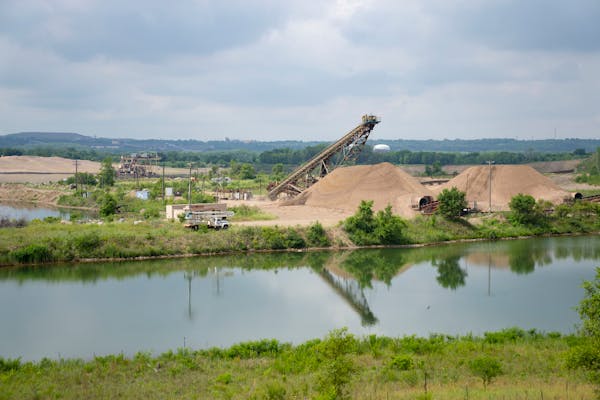A sand and gravel mining operation near Cottage Grove that hopes to continue digging along the Mississippi River is seeking approval to move each of its two quarries onto adjacent lands.
The moves by Holcim-MWR Inc., formerly Aggregate Industries, would allow it to continue digging up limestone for another 20 to 25 years in an area where it's been operating since the 1950s to produce sand and gravel for the construction of roads, bridges, commercial buildings and homes. The company said in documents released Wednesday that its Larson Quarry and Nelson Mine otherwise have only a few years of life remaining.
Both plans are coming up for public review from Dec. 3 to Jan. 17.
"These important expansions will allow Holcim to continue to supply construction projects in the Twin Cities and continue to employ the 45 hard working employees that support the operations," the company said in a statement Wednesday. "We are actively engaged in communicating with a wide range of stakeholders and are committed to thoroughly completing the environmental review process for both projects."
The mines have co-existed with nearby residents for decades in Grey Cloud Island Township and Cottage Grove, sometimes causing controversy as homeowners complain about noise, traffic and blasting operations. The Grey Cloud Island Township Board in 2022 denied two variances the company sought, saying residents feared lower property values and increased noise and vibrations. Several months later, Holcim asked Cottage Grove to annex 120 acres of its property, a move that would have taken away Grey Cloud Island Township's ability to regulate the mine as well as the tonnage tax — about $28,000 in 2022 — the township receives each year. Holcim later rescinded its annexation request.
A Washington County spokesperson said the board will listen to public comment and later determine if the existing plan for the Larson Quarry should go ahead or if further reviews will be necessary. A similar process will take place for the Nelson Mine plan, but with the city of Cottage Grove making the determination.
At the Larson Quarry in Grey Cloud Island Township, the company plans to expand the quarry onto a 148-acre parcel it owns to the east of County Road 75, according to the newly released environmental assessment worksheet.
Other details listed in the worksheet:
- The expansion would require relocating County Road 75 or building a bridge on the roadway, and depending on which option is chosen, the quarry will grow by 53 to 70 acres.
- Up to 75 acres will be cleared of vegetation and stripped of topsoil. This will be completed in phases to minimize the disturbed area at any given time throughout the life of the mine.
- The expansion would not require a change to the two water-appropriation permits already in place for the quarry, according to Holcim.
- Two federally listed endangered species may live in the active part of the project area, including the rusty patched bumble bee and the northern long-eared bat. A third endangered species, the Higgins-eye pearly mussel, may live within the project area but not in the active portion of the project. There is no critical habitat for any of the species identified within the project.
- After the area is quarried and the mine closed, it would become a lake with no outlet. Most of the perimeter would be nearly vertical limestone bluff while any slopes around the lake would be seeded with vegetation.
The worksheet also details the company's plans to mitigate noise, dust control, truck traffic and blasting operations to keep the expansion mine area in line with performance standards laid out in the Grey Cloud Island Township Zoning Ordinance.
Holcim also has plans for its Nelson Mine on Lower Grey Cloud Island, proposing to move it to a 395-acre parcel of privately owned land the company leases in the backwaters of the Mississippi on Lower Grey Cloud Island. The move, known as the Nelson Mine Backwaters Project, would occur over a 20- to 25-year period and allow the company to conduct mechanical dredging operations in backwaters of the Mississippi River.

Federal operation at Lake Street restaurant that drew protests was one of 8 across Twin Cities

MPCA intends to yank permit for St. Paul foundry accused of polluting the neighborhood

In surprise testimony, brother says Derrick Thompson was driving in crash that killed 5 Somali women

Their faces covered during Minneapolis raid, federal agents raise privacy worries

